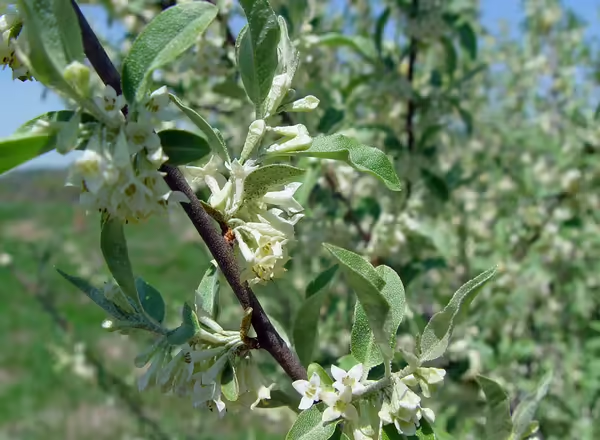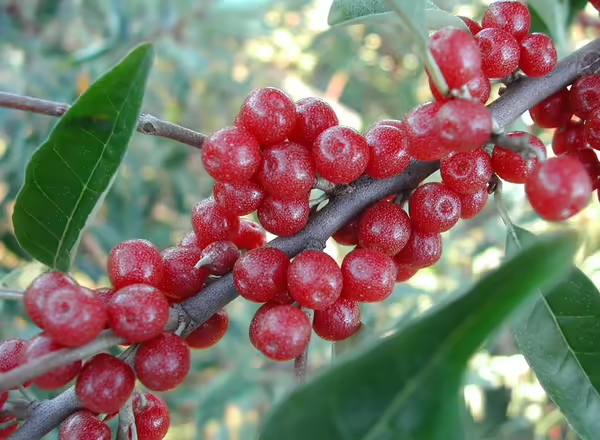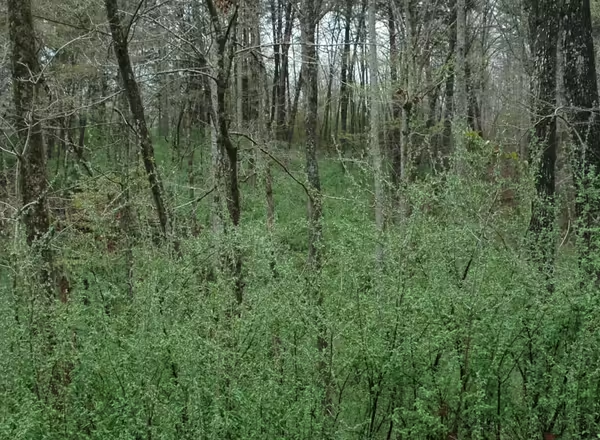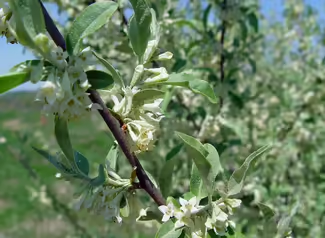
Invasive Autumn Olive
Autumn olive, Elaeagnus umbellata, can be found growing on disturbed sites such as roadsides, agricultural lands, and along streams and forest edges where partial to full sun is available. It spreads both by root suckers and via birds which readily feed on the fruit. Autumn olive’s dense foliage inhibits plant growth from below and can displace native plants. It has a competitive advantage because it alters the soil chemistry creating unfavorable conditions for native plants. Because autumn olive is a nitrogen-fixing species, in infested areas it can affect water quality by leaching nitrates.

Autumn olive was introduced into the U.S. around the 1830s primarily as an ornamental shrub. It was also planted extensively for soil stabilization, mining reclamation, and as a source of food for wildlife. It was once recommended to plant autumn olive next to crop plants, such as black walnut, as it could increase nitrogen in the soil by fixing it from the air.
Regulation of Autumn Olive
Autumn olive is listed as an invasive plant in Illinois through the Illinois Exotic Weed Act.

Autumn olive is an upright, multi-stemmed, woody shrub that can grow up to 20 feet tall. Its leaves are simple and ovate with a smooth/entire margin. Leaves are approximately 3 inches long, silver on the underside, and alternate down the stem.
Older stems are grey to brown and can appear furrowed. Newer stem growth is brown with silvery scales and white lenticels on younger stems. Short, thorn-like branches are often present down the stems. Fragrant, pale yellow to white flowers can be seen in clusters of four to six in the spring, later developing into red drupes with silver flecks in late summer.

- Mechanical: Autumn olive root systems are deep. Heavy machinery may be required to remove large plants.
- Cultural: Prescribed fire has little impact and is not recommended for autumn olive control.
- Chemical:
- On plants less than 6 feet tall, apply 2% to 4% v/v glyphosate in water or 1% to 2% v/v triclopyr in water.
- Basal bark: On plants 6 inches in diameter or less, apply a triclopyr ester formulation at a 20% to 30% v/v rate, mixed with basal oil, to the lowest 15 inches of the stem.
- Cut stump: Apply glyphosate at a 25% to 50% v/v rate in water or triclopyr amine in water or ester in oil at a 20% to 25% v/v rate within 10 minutes of cutting.
- Always read and follow the herbicide label before initiating treatment. If seeds are present on the plant, take care not to spread them during control.
Invasive plants have variable responses to fire depending on species, phenology at time of fire, fire intensities, residence time, and other factors. This presentation by Extension Forestry Research Technician Kevin Rohling reviews invasive plant responses to fire and how managers and landowners...

Presented by Ryan Pankau, Extension Educator, Horticulture Illinois forests are unique plant communities of towering trees as well as tiny, spring wildflowers. Invasive plants threaten native plant diversity in forest communities across Illinois by out-competing our natives for water, light, and...



